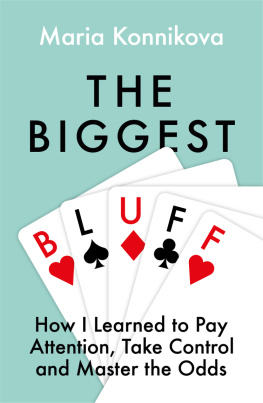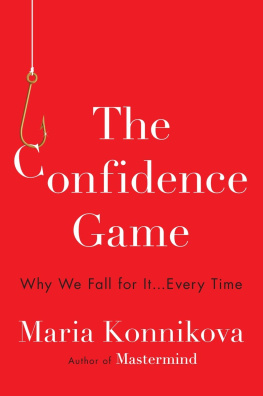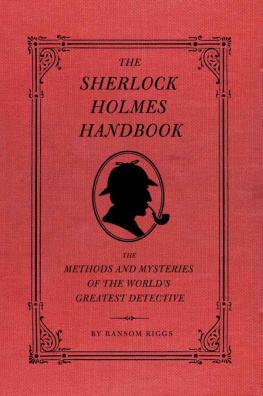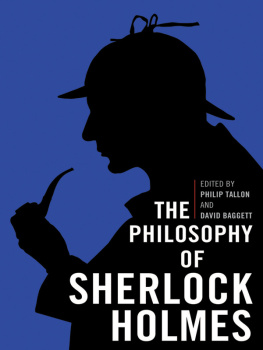
Published in Great Britain in 2013 by Canongate Books Ltd,
14 High Street, Edinburgh EH1 1TE
www.canongate.tv
This digital edition first published in 2013 by Canongate Books
Copyright Maria Konnikova, 2013
The moral right of the author has been asserted
Portions of this book appeared in a different form on the website Big Think (www.bigthink.com) and in Scientific American
First published in the United States of America by Viking Penguin, a member of the Penguin Group (USA) Inc., 375 Hudson Street, New York, New York 10013, USA
Photograph credits:
Page (bottom left): United States Government
(bottom right): Wikimichels (Creative Commons Attribution-Share Alike 3.0)
(bottom left): Biophilia curiosus (Creative Commons Attribution 3.0)
(bottom right): Brandon Motz (Creative Commons Attribution 2.0)
British Library Cataloguing-in-Publication Data
A catalogue record for this book is available on request from the British Library
ISBN 978 0 85786 724 7
Export ISBN 978 0 85786 725 4
eISBN 978 0 85786 726 1
Typeset in Minion Pro
Designed by Francesca Belanger
To Geoff
Choice of attentionto pay attention to this and ignore thatis to the inner life what choice of action is to the outer. In both cases man is responsible for his choice and must accept the consequences. As Ortega y Gasset said: Tell me to what you pay attention, and I will tell you who you are.
W . H . AUDEN
CONTENTS
PART ONE
CHAPTER ONE
CHAPTER TWO
PART TWO
CHAPTER THREE
CHAPTER FOUR
PART THREE
CHAPTER FIVE
CHAPTER SIX
PART FOUR
CHAPTER SEVEN
CHAPTER EIGHT
Prelude
W hen I was little, my dad used to read us Sherlock Holmes stories before bed. While my brother often took the opportunity to fall promptly asleep on his corner of the couch, the rest of us listened intently. I remember the big leather armchair where my dad sat, holding the book out in front of him with one arm, the dancing flames from the fireplace reflecting in his black-framed glasses. I remember the rise and fall of his voice as the suspense mounted beyond all breaking points, and finally, finally, at long last the awaited solution, when it all made sense and Id shake my head, just like Dr. Watson, and think, Of course; its all so simple now that he says it . I remember the smell of the pipe that my dad himself would smoke every so often, a fruity, earthy mix that made its way into the folds of the leather chair, and the outlines of the night through the curtained French windows. His pipe, of course, was ever-so-slightly curved just like Holmess. And I remember that final slam of the book, the thick pages coming together between the crimson covers, when hed announce, Thats it for tonight. And off wed gono matter how much begging and pleading wed try and what sad faces wed makeupstairs, up to bed.
And then theres the one thing that wedged its way so deeply into my brain that it remained there, taunting me, for years to come, when the rest of the stories had long since faded into some indeterminate background and the adventures of Holmes and his faithful Boswell were all but forgotten: the steps.
The steps to 221B Baker Street. How many were there? Its the question Holmes brought before Watson in A Scandal in Bohemia, and a question that never once since left my mind. As Holmes and Watson sit in their matching armchairs, the detective instructs the doctor on the difference between seeing and observing. Watson is baffled. And then, all at once everything becomes crystal clear.
When I hear you give your reasons, [Watson] remarked, the thing always appears to me to be so ridiculously simple that I could easily do it myself, though at each successive instance of your reasoning, I am baffled until you explain your process. And yet I believe that my eyes are as good as yours.
Quite so, [Holmes] answered, lighting a cigarette, and throwing himself down into an armchair. You see, but you do not observe. The distinction is clear. For example, you have frequently seen the steps which lead up from the hall to this room.
Frequently.
How often?
Well, some hundreds of times.
Then how many are there?
How many? I dont know.
Quite so! You have not observed. And yet you have seen. That is just my point. Now, I know that there are seventeen steps, because I have both seen and observed.
When I first heard it, on one firelit, pipe-smoke-filled evening, the exchange shook me. Feverishly, I tried to remember how many steps there were in our own house (I had not the faintest idea), how many led up to our front door (I drew a beautiful blank), how many led down to the basement (ten? twenty? I couldnt even approximate). And for a long time afterward, I tried to count stairs and steps whenever I could, lodging the proper number in my memory in case anyone ever called upon me to report. Id make Holmes proud.
Of course, Id promptly forget each number I so diligently tried to rememberand it wasnt until later that I realized that by focusing so intently on memorization, Id missed the point entirely. My efforts had been doomed from the start.
What I couldnt understand then was that Holmes had quite a bit more than a leg up on me. For most of his life, he had been honing a method of mindful interaction with the world. The Baker Street steps? Just a way of showing off a skill that now came so naturally to him that it didnt require the least bit of thought. A by-the-way manifestation of a process that was habitually, almost subconsciously, unfolding in his constantly active mind. A trick, if you will, of no real consequence, and yet with the most profound implications if you stopped to consider what made it possible. A trick that inspired me to write an entire book in its honor.
The idea of mindfulness itself is by no means a new one. As early as the end of the nineteenth century, William James, the father of modern psychology, wrote that the faculty of voluntarily bringing back a wandering attention, over and over again, is the very root of judgment, character, and will.... An education which should improve this faculty would be the education par excellence. That faculty, at its core, is the very essence of mindfulness. And the education that James proposes, an education in a mindful approach to life and to thought.
In the 1970s, Ellen Langer demonstrated that mindfulness could reach even further than improving judgment, character, and will. A mindful approach could go as far as to make elderly adults feel and act youngerand could even improve their vital signs, such as blood pressure, and their cognitive function. In recent years, studies have shown that meditation-like thought (an exercise in the very attentional control that forms the center of mindfulness), for as little as fifteen minutes a day, can shift frontal brain activity toward a pattern that has been associated with more positive and more approach-oriented emotional states, and that looking at scenes of nature, for even a short while, can help us become more insightful, more creative, and more productive. We also know, more definitively than we ever have, that our brains are not built for multitaskingsomething that precludes mindfulness altogether. When we are forced to do multiple things at once, not only do we perform worse on all of them but our memory decreases and our general well-being suffers a palpable hit.
But for Sherlock Holmes, mindful presence is just a first step. Its a means to a far larger, far more practical and practically gratifying goal. Holmes provides precisely what William James had prescribed: an education in improving our faculty of mindful thought and in using it in order to accomplish more, think better, and decide more optimally. In its broadest application, it is a means for improving overall decision making and judgment ability, starting from the most basic building block of your own mind.
Next page











